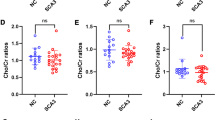Abstract
Objective
Anti-glutamic acid decarboxylase 65 (anti-GAD65)-associated neurological disorders include two major phenotypes, namely Stiff person syndrome (SPS) and cerebellar ataxia (CA). Considering the potential for better outcomes with prompt immunotherapy, early detection of CA is crucial. Hence, a non-invasive imaging biomarker to detect CA with high specificity is desired. Herein, we evaluated brain 2-deoxy-2-[18F]fluoro-D-glucose (18F-FDG) PET in detecting CA based on cerebellar uptake using receiver operating characteristic (ROC) analysis and five-fold cross-validation.
Methods
This study was based on STARD 2015 guidelines: thirty patients with anti-GAD65-associated neurological disorders, 11 of whom with CA were studied. Five test sets were created after patients were randomly sorted and divided into 5 equal folds. Each iteration included 24 patients for ROC analysis and 6 patients reserved for testing. The Z scores of left cerebellum, vermis, right cerebellum, and the average of the three regions were used in ROC analysis to determine areas with significant area under the curve (AUC). The cut-off values with high specificity were determined among the 24 patients in each iteration and tested against the reserved 6 patients.
Results
Left cerebellum and average of the three regions showed significant AUC above 0.5 in all iterations with left cerebellum being the highest AUC in 4 iterations. Testing the cut-off values of the left cerebellum against the reserved 6 patients in each iteration showed 100% specificity with sensitivities ranging from 0 to 75%.
Conclusions
Cerebellar 18F-FDG PET uptake can differentiate CA phenotypes from patients with SPS with high specificity.



Similar content being viewed by others
Data availability
The data is provided as a supplementary file.
References
Alexopoulos H, Dalakas MC. Immunology of stiff person syndrome and other GAD-associated neurological disorders. Expert Rev Clin Immunol. 2013;9:1043–53.
Newsome SD. Other proven and putative autoimmune disorders of the CNS: Anti-GAD associated neurological disorders—Stiff-Person Syndrome, cerebellar ataxia, progressive encephalopathy with rigidity and myoclonus, and encephalitis. In: Neurobiology of Disease. 2 ed. New York: Oxford Academic; 2016.
Shaw PJ. Stiff-man syndrome and its variants. Lancet. 1999;353:86–7.
Wang Y, Tourkevich R, Bosley J, Gold DR, Newsome SD. Ocular motor and vestibular characteristics of antiglutamic acid decarboxylase-associated neurologic disorders. J Neuroophthalmol. 2020. https://doi.org/10.1097/WNO.0000000000001084.
Kono S, Miyajima H, Sugimoto M, Suzuki Y, Takahashi Y, Hishida A. Stiff-person syndrome associated with cerebellar ataxia and high glutamic acid decarboxylase antibody titer. Intern Med. 2001;40:968–71.
Vulliemoz S, Vanini G, Truffert A, Chizzolini C, Seeck M. Epilepsy and cerebellar ataxia associated with anti-glutamic acid decarboxylase antibodies. J Neurol Neurosurg Psychiatry. 2007;78:187–9.
Raju R, Rakocevic G, Chen Z, Hoehn G, Semino-Mora C, Shi W, et al. Autoimmunity to GABAA-receptor-associated protein in stiff-person syndrome. Brain. 2006;129:3270–6.
Folli F, Solimena M, Cofiell R, Austoni M, Tallini G, Fassetta G, et al. Autoantibodies to a 128-kd synaptic protein in three women with the stiff-man syndrome and breast cancer. N Engl J Med. 1993;328:546–51.
Masangkay N, Basu S, Moghbel M, Kwee T, Alavi A. Brain 18F-FDG-PET characteristics in patients with paraneoplastic neurological syndrome and its correlation with clinical and MRI findings. Nucl Med Commun. 2014;35:1038–46.
Hosoi Y, Suzuki-Sakao M, Terada T, Konishi T, Ouchi Y, Miyajima H, et al. GABA-A receptor impairment in cerebellar ataxia with anti-glutamic acid decarboxylase antibodies. J Neurol. 2013;260:3086–92.
Vale TC, Pedroso JL, Alquéres RA, Dutra LA, Barsottini OGP. Spontaneous downbeat nystagmus as a clue for the diagnosis of ataxia associated with anti-GAD antibodies. J Neurol Sci. 2015;359:21–3.
Budhram A, Sechi E, Flanagan EP, Dubey D, Zekeridou A, Shah SS, et al. Clinical spectrum of high-titre GAD65 antibodies. J Neurol Neurosurg Psychiatry. 2021. https://doi.org/10.1136/jnnp-2020-325275.
Ariño H, Gresa-Arribas N, Blanco Y, Martínez-Hernández E, Sabater L, Petit-Pedrol M, et al. Cerebellar ataxia and glutamic acid decarboxylase antibodies: immunologic profile and long-term effect of immunotherapy. JAMA Neurol. 2014;71:1009–16.
Graus F, Saiz A, Dalmau J. GAD antibodies in neurological disorders - insights and challenges. Nat Rev Neurol. 2020;16:353–65.
Bossuyt PM, Reitsma JB, Bruns DE, Gatsonis CA, Glasziou PP, Irwig L, et al. STARD 2015: an updated list of essential items for reporting diagnostic accuracy studies. Radiology. 2015;277:826–32.
Hadavi S, Noyce AJ, Leslie RD, Giovannoni G. Stiff person syndrome. Pract Neurol. 2011;11:272–82.
Chang T, Lang B. GAD antibodies in stiff-person syndrome. Neurology. 2004;63:1999–2000.
Mitoma H, Manto M, Hampe CS. Immune-mediated cerebellar ataxias: from bench to bedside. Cerebellum Ataxias. 2017;4:16.
Hammers A. Flumazenil positron emission tomography and other ligands for functional imaging. Neuroimaging Clin N Am. 2004;14:537–51.
Huang ZJ, Di Cristo G, Ango F. Development of GABA innervation in the cerebral and cerebellar cortices. Nat Rev Neurosci. 2007;8:673–86.
Funding
This publication was supported by the National Institute of Biomedical imaging and Bioengineering of the National Institutes of Health under award number T32EB006351.
Author information
Authors and Affiliations
Corresponding author
Additional information
Publisher's Note
Springer Nature remains neutral with regard to jurisdictional claims in published maps and institutional affiliations.
Supplementary Information
Below is the link to the electronic supplementary material.
Rights and permissions
Springer Nature or its licensor (e.g. a society or other partner) holds exclusive rights to this article under a publishing agreement with the author(s) or other rightsholder(s); author self-archiving of the accepted manuscript version of this article is solely governed by the terms of such publishing agreement and applicable law.
About this article
Cite this article
Sadaghiani, M.S., Roman, S., Wang, Y. et al. Assessment of anti-GAD65-associated cerebellar ataxia with 18F-FDG cerebellar uptake: ROC analysis. Ann Nucl Med 37, 528–534 (2023). https://doi.org/10.1007/s12149-023-01853-w
Received:
Accepted:
Published:
Issue Date:
DOI: https://doi.org/10.1007/s12149-023-01853-w




